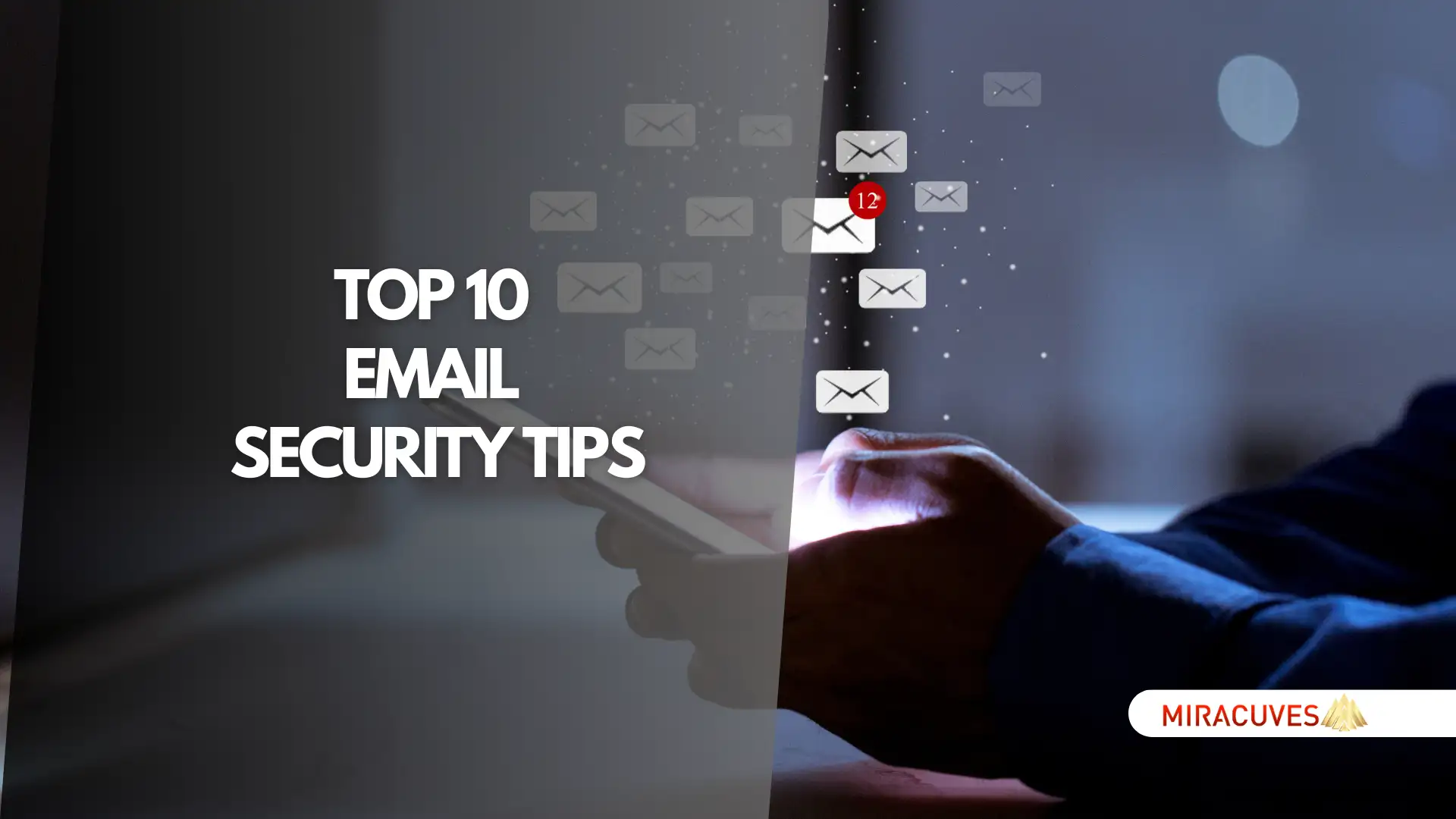In today’s digital landscape, email remains one of the primary communication tools, but it’s also a significant vulnerability for businesses. Cybercriminals constantly evolve their tactics, targeting email systems with sophisticated attacks, including phishing, malware, and business email compromise. According to recent studies, over 90% of all cyberattacks begin with an email, making email security more critical than ever.
If you’ve ever worried about the security of your business email system, you’re not alone. With the increasing complexity of email threats, businesses must adopt robust email security solutions to protect sensitive data and maintain trust. This guide will provide you with the top 10 actionable tips to solve the email security problem once and for all. From deploying multi-factor authentication to using data encryption, these strategies will help safeguard your organization from email-based threats and strengthen your cybersecurity posture.
Let’s dive into practical steps that will help you fortify your email system against evolving threats.
Tip 1: Implement Multi-Factor Authentication (MFA)
One of the most effective ways to enhance email security is by implementing multi-factor authentication (MFA). MFA adds an additional layer of protection by requiring users to verify their identity through multiple means beyond just a password. For example, after entering a password, users may need to input a code sent to their mobile device or authenticate via a biometric scan.
Why is this crucial for email security? Passwords alone are often vulnerable to breaches, phishing attacks, or weak password choices. With MFA, even if an attacker obtains a password, they cannot access the email account without the second authentication factor. This significantly reduces the chances of business email compromise, which is a common attack vector for cybercriminals.
Businesses can easily integrate MFA with tools like Google Authenticator or Duo Security, offering users seamless verification while strengthening their email security posture. Moreover, MFA is a quick win for organizations that want to secure not only their email systems but also their broader IT infrastructure.
By adopting MFA, companies can dramatically lower the risk of unauthorized access, ensuring that sensitive data remains protected from hackers.
Tip 2: Deploy Advanced Email Filtering Tools
Another essential step in solving email security issues is deploying advanced email filtering tools. These tools act as a frontline defense, automatically scanning incoming and outgoing emails for suspicious activity, malicious attachments, and known threat signatures. By filtering out potentially dangerous emails, businesses can significantly reduce their exposure to phishing attacks, malware, and spam.
Top-rated solutions like Proofpoint and Mimecast are widely used for their powerful filtering capabilities. These tools offer protection against various email-based threats, including phishing protection, malware prevention, and email fraud prevention. They use machine learning to detect patterns and adapt to new threats, ensuring that your system is always up to date.
| Email Filtering Tool | Key Features | Use Case | Threats Blocked |
|---|---|---|---|
| Proofpoint | Advanced phishing protection, attachment sandboxing, email encryption | Ideal for enterprise-level email security | Phishing, malware, spam, business email compromise |
| Mimecast | Email filtering, secure email gateway, URL protection | Suitable for medium to large businesses | Ransomware, phishing, malicious links |
| Barracuda | Spam filtering, inbound and outbound filtering, DLP (Data Loss Prevention) | Best for businesses with heavy email traffic | Spam, malware, data leaks, phishing |
In addition to blocking harmful emails, these tools often include anti-spam software and email breach response features, allowing businesses to monitor, quarantine, and respond to any suspicious email activity quickly. Regularly updating and configuring these filters is crucial for maintaining a robust defense.
By integrating email filtering tools, you can ensure that only legitimate emails make it through to your inbox, minimizing the chances of falling victim to email-borne attacks.
Tip 3: Strengthen Phishing Protection with Employee Training
While technology plays a significant role in email security, the human factor is often the weakest link. Phishing attacks target employees through deceptive emails, tricking them into revealing sensitive information or downloading malicious software. To combat this, it’s crucial to strengthen phishing protection through comprehensive employee training.
Training should focus on teaching employees to identify phishing attack indicators such as mismatched URLs and suspicious attachments. For more detailed insights, refer to these phishing protection best practices provided by the U.S. Cybersecurity and Infrastructure Security Agency (CISA).
Employees need to be aware of the various forms of phishing attacks, including spear phishing (targeted attacks) and whaling (attacks on senior executives). Training should focus on teaching staff how to identify red flags in emails, such as mismatched URLs, suspicious attachments, and unusual requests for personal or financial information.
One effective method is conducting simulated phishing tests to see how employees react in real-world scenarios. These tests help identify areas of improvement and reinforce key lessons in cybersecurity best practices. Additionally, regularly updating training programs ensures employees stay informed about evolving threats.
Empowering your workforce with the knowledge to recognize and avoid phishing attempts is one of the most critical steps in preventing business email compromise and reducing the risk of cyberattacks. Remember, a well-trained employee is the first line of defense against phishing threats.
Read More “How Much Does It Cost to Develop a Trikart-Like eCommerce App? A Complete Guide“
Tip 4: Secure Your Email Gateway
A secure email gateway is essential for protecting your business from email-borne threats before they even reach your inbox. An email gateway acts as a barrier between your email server and the outside world, filtering out potentially harmful content such as malware, phishing attempts, and spam. It scans all incoming and outgoing emails to ensure that no malicious data can penetrate your system.
Top solutions like Barracuda and Cisco Email Security offer robust email gateway protection. These tools are designed to detect and block both known and emerging threats by employing threat detection systems and machine learning algorithms. They can prevent a wide range of attacks, from business email compromise to email fraud prevention.
For businesses that handle sensitive data, a secure email gateway also ensures compliance with security standards and regulations. It can enforce data encryption and prevent sensitive information from being leaked through unauthorized email transmissions.
By deploying a secure email gateway, companies can significantly reduce their vulnerability to external attacks, ensuring safer email communication and protecting the business from potentially devastating breaches. Implementing this solution strengthens the entire cybersecurity infrastructure.
Tip 5: Use Data Encryption for Email Security
One of the most effective ways to protect sensitive information in emails is through data encryption. Encryption ensures that even if an email is intercepted by a cybercriminal, its contents remain unreadable without the proper decryption key. This adds a vital layer of security to email communication, making it indispensable for organizations handling sensitive or confidential information.
Two widely used encryption protocols are Transport Layer Security (TLS) and Pretty Good Privacy (PGP). TLS encrypts the connection between email servers, ensuring that emails are protected during transit. PGP, on the other hand, offers end-to-end encryption, meaning the email remains encrypted from the moment it’s sent until the recipient decrypts it.
By using protocols like TLS and PGP, businesses can ensure secure email communication and prevent unauthorized access. For step-by-step guidance, check out this resource on how to implement email encryption protocols.
By enabling encryption, businesses can prevent unauthorized access and protect against email-based threats like business email compromise. Many modern email platforms offer built-in encryption features, making it easier to implement across the organization. However, it’s important to regularly update encryption protocols to keep up with evolving cybersecurity standards.
| Encryption Protocol | Description | Level of Security | Use Case | Compliance |
|---|---|---|---|---|
| TLS (Transport Layer Security) | Encrypts email during transit between servers, widely adopted by most email services. | Moderate | Ensures email security during transit | Meets GDPR and HIPAA requirements |
| PGP (Pretty Good Privacy) | End-to-end encryption ensuring only sender and recipient can decrypt the message. | High | Used for highly confidential communication | Complies with strict data protection laws |
| S/MIME (Secure/Multipurpose Internet Mail Extensions) | Provides encryption and digital signatures for email. | High | Suitable for enterprise email encryption | HIPAA, GDPR, and PCI-DSS compliant |
Integrating data encryption not only enhances secure email communication, but also helps organizations comply with regulations such as GDPR and HIPAA, ensuring that sensitive data remains protected at all times.
Tip 6: Establish a Response Plan for Email Breaches
No matter how robust your email security measures are, it’s essential to have an email breach response plan in place. Cyberattacks can occur despite preventative measures, and being prepared to respond quickly can minimize damage and protect your business from further exposure.
| Step | Action | Purpose |
|---|---|---|
| Identify and Contain | Detect the breach, isolate affected accounts and devices. | Stop unauthorized access immediately |
| Notify Stakeholders | Inform employees, clients, regulators, and other relevant parties about the breach. | Maintain transparency and compliance |
| Investigate the Breach | Determine how the breach occurred and the extent of the damage. | Prevent similar future attacks |
| Remediate & Recover | Secure compromised accounts, update credentials, and patch vulnerabilities. | Strengthen defenses and regain control |
| Post-Breach Assessment | Analyze the incident to extract key lessons and improve email security protocols. | Ensure continuous improvement in security |
An effective response plan should include the following steps:
- Identify and Contain the Breach: The first step is to identify the breach, isolate the affected email accounts, and prevent further unauthorized access.
- Notify Stakeholders: Inform key stakeholders, including employees, clients, and regulators, if necessary, about the breach. Transparency helps maintain trust and complies with regulatory requirements.
- Investigate the Incident: Determine the cause of the breach and the scope of the damage. This step is critical for preventing future incidents.
- Remediate and Recover: Secure compromised accounts, update passwords, and ensure that any vulnerabilities that led to the breach are addressed.
- Post-Breach Assessment: Conduct a thorough review to understand the lessons learned and make adjustments to your email security solutions.
A well-defined email breach response plan not only helps contain the threat but also positions your business to recover quickly and bolster defenses against future attacks.
Tip 7: Invest in Anti-Spam and Malware Prevention Software
Anti-spam software and malware prevention tools are critical components of a strong email security strategy. Spam emails often serve as a delivery mechanism for malicious content, including malware, ransomware, and phishing links. By filtering out spam, you significantly reduce the risk of such attacks reaching your employees’ inboxes.
Leading anti-spam solutions, such as SpamTitan and Bitdefender, are designed to block unwanted emails and prevent harmful attachments from making their way into your email system. These tools work by scanning incoming emails for known malware signatures and suspicious behaviors, ensuring that potential threats are quarantined before they can cause harm.
Additionally, anti-spam tools often integrate with email filtering systems to create a comprehensive defense against email-based attacks. Many of these platforms also include real-time threat detection, updating their databases continuously to adapt to new and emerging threats.
For businesses, investing in malware prevention software and anti-spam tools not only safeguards against potential data breaches but also reduces the risk of downtime caused by security incidents. It’s a proactive approach that strengthens your organization’s overall email security solutions and helps maintain the integrity of your communication systems.
Tip 8: Regularly Update Email Security Protocols
Cyber threats evolve rapidly, and what protected your email system a few months ago might not be sufficient today. This is why it’s crucial to regularly update email security protocols. Keeping your systems and software up to date ensures that you are protected against the latest vulnerabilities and exploits.
One key aspect of maintaining secure email communication is ensuring that all patches and updates are applied as soon as they’re released. Many cyberattacks take advantage of outdated software with known security flaws, so timely updates are essential. For businesses using tools like email gateways, anti-spam software, and email filtering tools, regular updates keep these systems functioning optimally and adapting to new threats.
Additionally, encryption protocols such as TLS should be updated regularly to maintain the highest levels of security. Encryption standards evolve, and staying compliant with current regulations like GDPR and HIPAA requires that your encryption methods are both modern and effective.
By establishing a routine schedule for reviewing and updating your email security solutions, you minimize the risk of security breaches and ensure that your business stays ahead of potential cyber threats.
Tip 9: Invest in Threat Detection Systems
Proactively identifying and mitigating potential email threats is essential for maintaining robust email security. This is where threat detection systems come into play. These systems monitor email traffic for suspicious activities and behaviors, allowing businesses to detect and respond to threats before they can cause damage.
Modern threat detection tools, such as Cisco Umbrella and FireEye, use advanced analytics and machine learning algorithms to spot anomalies in email patterns. They can detect everything from phishing protection failures to malware prevention gaps, alerting security teams to potential risks in real-time. This proactive approach helps businesses stay one step ahead of cybercriminals, reducing the chances of an undetected breach.
For enterprises, investing in threat detection systems is a key part of their email security infrastructure. These systems work hand-in-hand with other security measures, such as secure email gateways and anti-spam software, to provide a multi-layered defense against email-based attacks.
By integrating threat detection into your overall security strategy, you gain the ability to swiftly identify and neutralize threats, ensuring your email system remains secure and resilient against both current and emerging threats.
Tip 10: Ensure Compliance with Email Security Regulations
In addition to protecting your email system from cyber threats, it’s crucial to ensure that your business complies with industry-specific email security regulations. Regulations such as GDPR, HIPAA, and PCI-DSS impose strict guidelines on how businesses handle sensitive information, particularly when it comes to email communication.
Compliance involves implementing cybersecurity best practices, including the use of data encryption, secure storage of sensitive information, and maintaining audit trails for email transmissions. Failing to meet these standards can result in significant legal and financial penalties, as well as reputational damage. For example, businesses that handle healthcare information must follow HIPAA guidelines, which dictate strict security measures to protect patient data, including in email communication.
To ensure compliance, businesses should regularly review and update their email security solutions to align with the latest regulatory requirements. This includes ensuring that encryption protocols are up to date and that all security measures are documented and auditable.
By adhering to regulatory standards and implementing the necessary security measures, your business not only avoids penalties but also fosters trust with clients and stakeholders, demonstrating a strong commitment to email security and data protection.
Conclusion
Email security is no longer just a best practice—it’s a necessity in today’s ever-evolving threat landscape. By implementing the strategies outlined in this guide, including multi-factor authentication, email filtering tools, and data encryption, your business can effectively mitigate the risks posed by email-based attacks. Taking proactive steps such as investing in threat detection systems and ensuring compliance with industry regulations further strengthens your defenses.
The key to solving the email security problem lies in a comprehensive approach that combines the right tools, regular updates, and employee training. By adopting these practices, you not only protect your business from potential breaches but also build a foundation of trust with your customers and partners.
Now is the time to act—start applying these tips today to safeguard your email systems and stay ahead of cyber threats.
Stay Ahead with Miracuves – Your Partner in IT Excellence
In today’s fast-paced digital world, staying ahead in IT is essential to success. Whether it’s developing cutting-edge apps, implementing robust cybersecurity, or adopting the latest tech trends, Miracuves is your partner in delivering solutions that keep your business on top including a Email Marketing Solution Like Mailchimp. Don’t let your competitors outpace you—transform your digital landscape with expert guidance and innovative solutions from Miracuves.
Contact us today to future-proof your IT infrastructure and stay ahead of the curve!
FAQs
What is the most effective way to secure business emails?
The most effective way to secure business emails is by implementing multi-factor authentication (MFA), using email filtering tools, and enabling data encryption. These steps help prevent unauthorized access and protect against phishing and malware attacks.
How does email encryption work?
Email encryption works by converting the contents of an email into a code to prevent unauthorized access. Only the sender and the intended recipient with the decryption key can read the email, ensuring secure email communication.
Why is phishing protection important for businesses?
Phishing attacks trick employees into sharing sensitive information or clicking on malicious links. Phishing protection is crucial as it helps prevent business email compromise and protects confidential data from being stolen or misused.
What are the best email filtering tools?
Top email filtering tools include Proofpoint, Mimecast, and Barracuda. These tools block spam, phishing emails, and malicious attachments, enhancing overall email security solutions.
What should I do if my business experiences an email breach?
If your business experiences an email breach, immediately identify and contain the breach, notify stakeholders, and investigate the cause. Implement a thorough email breach response plan to mitigate further risks and prevent future attacks.
How can anti-spam software improve email security?
Anti-spam software helps filter out unwanted and malicious emails before they reach your inbox. By blocking spam and potential malware, anti-spam tools are an essential part of any enterprise email security strategy.









